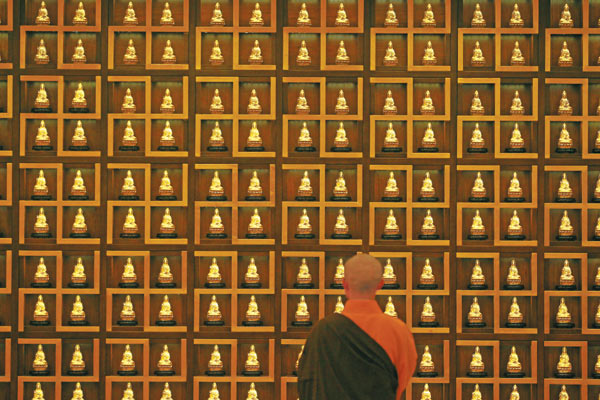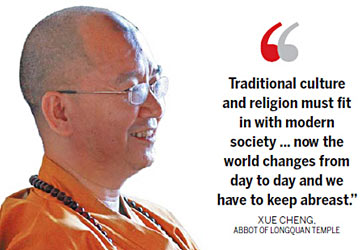The Modern Monks of China
Updated: 2011-07-17 10:58
By Tang Yue (China Daily)
|
|||||||||||
 |
|
A young monk contemplates a wall of the gilded images of Buddha in the main hall of the Longquan Temple in Beijing's Haidian district. [Photo by Cui meng / China Daily] |
|
||||
The world-weary have sought refuge in Buddhist temples for thousands of years, shedding their earthly entanglements for a higher calling. But what about now? Tang Yue goes into retreat to find out more about the Buddhist monks of 21st-century China.
Buddhism in China is about 2,000 years old. It has had a roller-coaster history with its popularity reaching a peak during the Tang Dynasty (AD 618-907).
It was during this period that Xuan Zang, its most ardent advocate and arguably China's most famous monk, traveled overland to India in search of original Buddhist scriptures. His journey took 17 years, and it became the stuff of legends, including the inspiration for Wu Cheng'en's novel Journey to the West, an allegory spiced up with the fictional disciples Monkey, Piggy and Sharky, a sort of China's equivalent to John Bunyan's Pilgrim's Progress.
As New China hurtled into socialism, religion took a backseat as revolutionary fervor became the faith of the day. China was changing and it had other priorities. Fast-forward again to the 2010s, and today's Buddhist leaders are looking at a revival. As life gets more comfortable, and urban pressures increase, the resulting paradox has stirred up spiritual needs.
But 14 centuries after Buddhism set root in China, it is a very different scenario. There are now new platforms from which to evangelize and preach. While the monks of yore had to trudge far to spread Buddhist teachings, the modern missionaries are able to communicate with a click of the mouse. There are online sermons, and many religious leaders make use of that very useful networking tool - the microblogs. Sometimes, they even blog in many languages.
We got a first-hand look at how it works at Beijing's Longquan Temple in Fenghuangling, a Buddhist sanctuary built in the Liao Dynasty more than 1,000 years ago.
Like many monasteries all over the country, it has withstood the tribulations of history. The latest was during the turbulence of the "cultural revolution", when it became a silent shell.
Since then, more than 100 young men, many of them graduates from the most prestigious Chinese universities, have been tonsured here.
One of them, Chan Xing, has a doctorate in fluid dynamics from Tsinghua University. He was one of those who followed the abbot here from Fujian province six years ago, and he recalls those early days.
"There were only three bungalows here, with no heating system. The winters were really torturous," he remembers.
Now, there is a fully heated multi-story dormitory, a library, computer room and laundry room - "just like a campus". There is even a garbage recycling system.
"You can see the construction site over there. I don't think we will stop building in the next 10 years because the number of residents keeps growing," Chan Xing says as he leads us to the work-site on a sunny afternoon.
Hot Topics
Philippines President Benigno Aquino III (C) plants a tree with Chinese government officials at a clan hall in Hongjian village, Zhangzhou city of East China's Fujian province, on Saturday.
Editor's Picks

|

|

|

|

|

|








